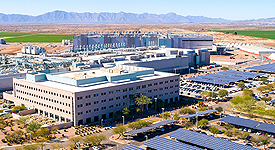Chandler's drinking water supplies come from both surface water and groundwater. Chandler also utilizes reclaimed water supplies to serve more than 400 direct-use customers who are connected to the reclaimed water distribution system for the purpose of irrigation and/or industrial demands.
Here in Chandler, our water supply comes from three sources:
- Surface Water
Surface water comes from rain and snow that fall in the watershed, runs off into rivers and streams and collect in reservoirs. Chandler has surface water rights in both the Colorado River watershed and the Salt and Verde watershed. The Salt and Verde watershed is entirely within the state of Arizona, where the Colorado River watershed extends across seven states and the country of Mexico.
Dams and reservoirs allow us to store extra water during wet years, so that it can be used to supplement our water supply in dry years. Salt River Project (SRP) delivers water from the Salt and Verde watershed using an extensive system of dams, reservoirs and canals. Central Arizona Project (CAP) delivers water from the Colorado River over 336 miles from the western border of our state into Central Arizona.
- Groundwater
Chandler has 32 active groundwater wells used to supplement our drinking water supplies when needed. In normal years, approximately 6% to 10% of Chandler's annual water use comes from groundwater. Groundwater is a finite resource and nearly all the water in our local aquifer is fossil groundwater that has accumulated over thousands of years. ASU Groundwater Report
- Reclaimed Water
Chandler has an extensive wastewater collection system and two water reclamation facilities to treat wastewater to Class A+ effluent. The reclaimed water distribution system includes a network of pumps and pipes to deliver reclaimed water to parks, schools, churches, businesses and golf courses.
It's up to us to use our water supply wisely and efficiently, so it will last for the future. It's easy to save water and can mean just watering your lawn at a different time of day, fixing a leak or tweaking your sprinkler system.
What Can I Do?
It takes only small changes to help save significant amounts of water. Here are some easy, inexpensive, everyday things you can do:
- Get on a smart schedule. Don't water your landscape every day. Only apply the amount of water that your plants really need depending on the season. Check out the recommended watering schedule for landscapes in Chandler. Note: Watering may not be needed during the winter for desert-adapted landscapes.
- Timing is everything. Water your lawn early in the morning or late in the evening. Midday watering results in fast evaporation, and scorches your lawn and plants.
- Control your controller. Know how to operate your in-ground sprinkler system controller. Check sprinkler systems frequently for directional aim and broken heads to prevent watering driveways, sidewalks and streets. If it has rained you may be able to turn skip a cycle or two.
- Slow the flow. Use low-flow sprinkler heads to water your grass, and become familiar with the "cycle and soak" setting on your controller. Use a drip system instead of sprinklers to water trees, shrubs and flower or vegetable beds more efficiently.
- Mow better. Raise your lawnmower blade and cut grass areas to a height of 3 inches. This shades the soil, which reduces evaporation and allows roots to grow deeper.
- Be soil-savvy. Use a 2 - 3 inch layer or inorganic mulch like ½" minus decomposed granite on top of your soil. Better yet, try a 3 inch layer or organic mulch (compost, finely shredded bark/wood). This helps retain moisture, prevents weeds and releases nutrients back into the soil as it decomposes.
- Grow native. Plant trees to create shade, and choose colorful, drought-tolerant or native groundcovers, shrubs and perennials. Ask your local nursery or landscape professional for advice, or browse the free, full-color booklet Landscape Plants for the Arizona Desert.
- Plug the leaks! Check for leaks in taps, toilets, pipes and your sprinkler system. Fixing leaks is a simple way to save water. One slow drip can waste 20 gallons of water daily (7,000 gallons per year).
It might not seem like much, but every time you practice one of these tips, you're not only using water more wisely and efficiently, but also saving water for our future.



